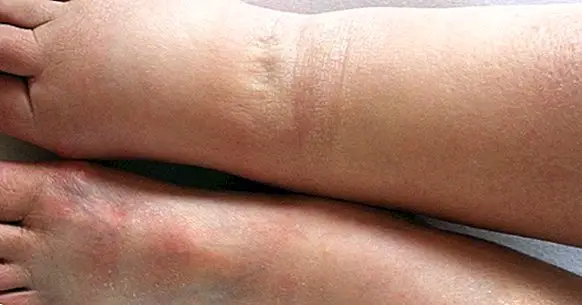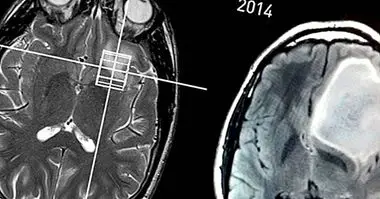Elephantiasis: symptoms, causes and treatments
There are a lot of diseases and disorders in the world, many of which are largely unknown to most of the world or tend to be strange given their low prevalence in our countries of origin.
However, some of them cause physiological alterations evident to the naked eye, something that makes them stand out and recognize or remember some existing cases. This is what happens with elephantiasis , also known as lymphatic filiarysis (although elephantiasis would make more reference to the symptom in question, they are often identified as synonyms).
- You may be interested: "The differences between syndrome, disorder and disease"
What is Elephantiasis?
We understand by elefantisasis the presence of a marked and evident swelling and thickening of the tissues that appears as a result of a blockage of the lymphatic system , that stops draining the lymph. It is the third phase of a lymphedema, in which the alterations become permanent. It usually appears in the chronic phase of lymphatic filariasis, to the point that lymphatic filariasis and elephantiasis are often identified and used as synonyms. Generally the thickening is produced in legs or arms, being also frequent the affectation of genitals and breasts. In many occasions it can generate pain in those who suffer it. The renal and immune systems are also often impaired, as are bones.
The deformities caused by this disorder can have serious consequences for the people who suffer from it, it is not strange the appearance of fistulas, wounds with the possibility of infection or even the appearance of tumors. At the functional level it can also profoundly alter the person's life, being able to alter or even disable the ability to walk or move, being a frequent cause of physical disability. If it occurs in the genitals, it also alters the sexual functionality.
The parasitic infection that generates it is usually of infantile origin, although in the majority of cases the symptoms begin to be observed in the adult age. This infection, in fact, can remain asymptomatic despite the damage to the lymphatic system.
Also, these alterations tend to be a source of great embarrassment and discomfort for those affected, many of them avoiding social contact and isolating themselves. In fact, even the term elephantiasis (which compares the legs of those affected with those of an elephant), can already be a source of stigma for them. Social and labor life are deeply affected as an indirect effect, and the appearance of malaise, depression and anxiety is not uncommon.
Is about a tropical disease mainly present in countries in Africa, South America, Central America or Indonesia . Although it may seem like a strange disease and it is easy to think that it is classifiable between rare and rare diseases, the truth is that it is more common than it appears: around 120 million people suffer from some form of this disorder. However, it is a disease that is little taken into account at a general level, having neglected the research regarding its treatment for years.
- Maybe you're interested: "The 15 most common nervous system diseases"
Appearance stages
It is possible to identify three phases in which elephantiasis is gradually occurring. Technically, the name elephantiasis correspodería to the third or last phase of the process, evolving the lymphedema (edema generated by lymph) in the process to reach a chronic phase.
1. Post-sprained edema
The first moment to consider is the appearance of the mosquito bite that transfers the filaria. Initially, no type of symptom may appear. In the cases in which it does occur, a palpable swelling is usually observed in the affected area, which will gradually increase. In the morning the swelling is imperceptible, but it resurfaces throughout the day . The skin is still soft.
2. Second phase: progression of lymphedema
In a second phase, the swelling has been increasing and is perceptible at all times, although it seems to be reduced even in the morning (something that with time will stop doing). The skin becomes harder little by little .
3. Elephantiasis
Third and last phase, in which the problem of swelling becomes irreversible and acquires a characteristic hardness. The level of swelling may increase, and the morphological changes are going to be permanent .
Causes of this disease
Elephantiasis is a problem that can have different causes, although the most common is infection by parasitic worms known as filarias . This parasite blocks the lymphatic system, something that generates edema or accumulation of fluids in different areas of the body.Specifically, the most common is the Wucheria bancrofti, although there are other species that also generate this disease. The parasite usually comes into contact with our organism through the bite of mosquitoes such as anopheles and culex, passing the infection from the blood to the lymphatic system (where the parasites feed and grow).
However, despite the fact that elephantiasis is usually produced for this reason, sometimes there may also be alterations that end up generating elephantiasis (if we understand it as a symptom and not as a disorder in itself). We would be talking about non-Filarian elephantiasis , caused by other injuries such as some of the metastasis of some tumors, other diseases or the consequences of a surgery that damaged the lymphatic system.
Treatments
The disease that causes elephantiasis can fortunately be treated by the use of different drugs and antiparasitics , especially in an acute and initial phase. Ivermectin or diethylcarbamazine are among the most commonly used and effective. The use of antibiotics and analgesics may also be required to fight infections and pain, which are frequent in this disease.
Keep in mind that even if parasites are killed, the malformations present in the chronic phase (that is, the extreme swelling of the affected parts) can remain for life. There are procedures such as compression therapies and surgery that can reverse the swelling, although it will be necessary to use compression mechanisms. The drainage or derivation of excess lymph can also be of great help . In these cases, compressive measures, establishment of hygienic guidelines to avoid infections and physiotherapy may be useful.
Although treatable, it is necessary to take into account the need to establish prevention plans. Hygiene and mosquito avoidance using mosquito nets or insecticides can help to prevent this disease, traditionally underserved worldwide (although the WHO has launched a global program for the elimination of lymphatic filariasis that is expected to achieve success around the year 2020).
Bibliographic references:
- Lozano, Y. (2009). Elephantiasis. On the basis of a case. Electronic Medical Journal, 31 (3). Matanzas, Cuba.
- Fenwick, A. (2012). The global burden of neglected tropical diseases. Public health, 126 (3): 233-236.
- Fortuny, E.I .; Guerreiro, M.F .; Pereira, J.M. (2014). Is lymphedema reversible? Rev. Chilena Dermatol .; 30 (4).



















